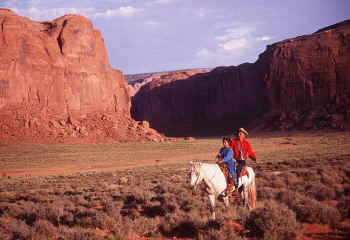Learning
among Traditional Native Americans (TNA)...
and other groups of similar culture
A Workshop for
Teachers
by Leecy Wise

Learning
among Traditional Native Americans (TNA)... by Leecy Wise |
 |
Forward |
Objectives | Introduction |
Assessing Needs | Characteristics of TNA Students |
Learning Concepts | Instructional Strategies
| Sample Lesson Plan
THIS PAGE AND ITS LINKS ARE
UNDER CONSTRUCTION. WATCH IT DEVELOP AND CONTRIBUTE
YOUR IDEAS!
|
This workshop/information is designed to assist well-meaning and committed instructors who teach Native American (NA) students and share our concern for their success. I have not worked long with traditional Native Americans (TNA). However, in the three short years I have lived in Cortez, Colorado, I have come to appreciate the culture shared by many different NA tribes and to recognize the crying need for educators to learn to teach concepts in a way that NA students can readily grasp them. I have also come to realize that many of the approaches that help NA students learn are the same that I have adopted for the last thirty years as an educator working with other minority-culture groups. By the end of this workshop, participants will be able to
Adults learn through association. Everybody knows that! Hmmm... Young people also learn through association to some extent. We relate to our environment. We learn to define ourselves, consciously or unconsciously, through our association with other people and events that surround us. If you come from a different environment than that of your students, what are you going to associate new information to? It is not uncommon for teachers to teach from the curriculum instead of from the classroom. The bureaucratic demands for accountability provide constant stress to teach the text and forget the student. Yet the best results occur when teacher and student join in the discovery process. Finding out what a student values, how she learned things, what he considers success, those are fundamental steps in planning instruction for anyone. Granted, if you have 45,000 students, you'll have to plan in broad categories; however, if you have fewer that that number, you should be able to establish a dialogue that will provide guidelines for instruction. ;-)
Traditional Native American students leave the traditional Anglo system by the droves (I don't know how many droves, but you can find out by getting drop-out rates for your part of the country by looking up the "drove index" for your area...) because it fails them. It fails to get to know them. It assesses their needs based on traditional Anglo values. It teaches them through linguistic, analytical, rational activities. It fails to connect to who they are, so it cannot possibly reach them unless they make the effort to become their own teachers and beat the system to their advantage. The same is true of many other minority cultures who struggle with traditional school systems in the United States. Some may argue that it is up to the student to adapt to the system, and some students do. I don't buy that approach. If you plant a seed, don't expect it to adapt to your soil or watering schedule. It has its own needs, and, with some exceptions, it will die in an environment that fails to recognize its needs. Fortunately, students, unlike plants, have a choice; they can leave the unfriendly environment and find a place where they can survive. And that is precisely what they do. Now I won't argue here about whether or not it is to the student's advantage to learn to function in a dominant culture that is foreign to her own. The purpose of this training is to argue that if a student chooses to do so, caring educators would do well to learn more about how that student functions and learns. That way, everyone wins. The educator watches the student blossom and grow; the student walks away with more choices. Good education, to me, reveals and trains the "educatee" in the art of making choices. DISCUSSION WHEEL
APPLICATION 1 Make four columns on a piece of paper. Write the following information in each assigned column.
Continue by clicking on the next topic, below.
Assessing Needs | Characteristics of TNA Students | |